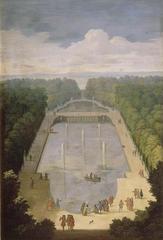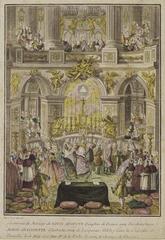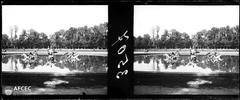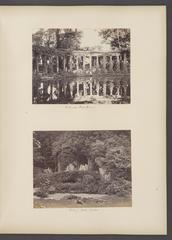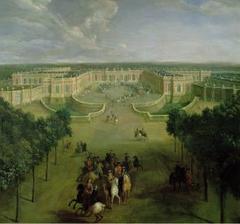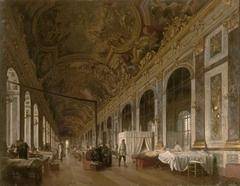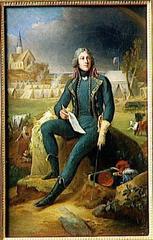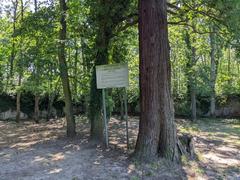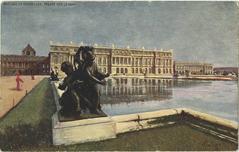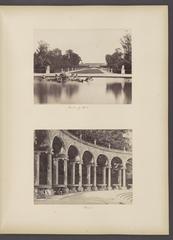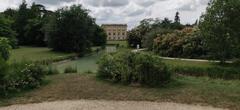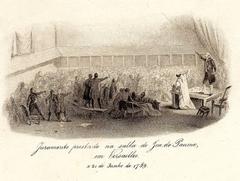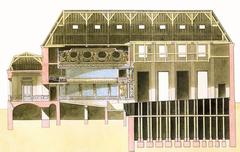Visiting Hours, Tickets, and Tips for Arboretum de Versailles-Chèvreloup, Versailles, France
Date: 19/07/2024
Introduction
Nestled in the historical city of Versailles, the Arboretum de Versailles-Chèvreloup is a botanical gem offering a unique blend of history, biodiversity, and recreational opportunities. Established in 1927, this arboretum is part of the National Museum of Natural History in Paris and spans over 200 hectares. Originally part of the royal hunting grounds of the Château de Versailles, it has evolved into a sanctuary for plant conservation, scientific research, and public education. With over 15,000 plant species from around the world, the arboretum is a vital resource for conservation and research, playing a crucial role in preserving biodiversity (National Museum of Natural History). Whether you are a history enthusiast, a plant lover, or simply seeking a serene escape from city life, the Arboretum de Versailles-Chèvreloup promises a fulfilling and enlightening experience.
Table of Contents
- Introduction
- History of Arboretum de Versailles-Chèvreloup
- Visitor Information
- Notable Collections and Features
- Educational and Research Initiatives
- Visitor Experience and Amenities
- FAQ
- Conclusion
History of Arboretum de Versailles-Chèvreloup
Origins and Early Development
The Arboretum de Versailles-Chèvreloup has a rich history dating back to the early 20th century. Established in 1927 as part of the National Museum of Natural History in Paris, its initial purpose was to create a living collection of trees and shrubs for scientific research and education. The site, formerly part of the royal hunting grounds of the Château de Versailles, was chosen for its historical significance and natural beauty.
Expansion and Scientific Contributions
During the 1930s, the arboretum underwent significant expansion under botanist Jean Dybowski. Dybowski aimed to create a comprehensive collection of woody plants from around the world. By the end of the decade, the arboretum had amassed a diverse collection of species, making it one of the most important botanical gardens in Europe. Many of the plants were used in scientific studies on plant physiology and taxonomy.
World War II and Post-War Recovery
The outbreak of World War II in 1939 brought challenges to the arboretum, leading to neglect and damage. Post-war recovery efforts were swift, with replanting and restoration projects in the late 1940s and 1950s. This period also saw the introduction of new species and the establishment of specialized sections, such as the conifer collection and the Mediterranean garden.
Modern Era and Conservation Efforts
In the latter half of the 20th century, the Arboretum de Versailles-Chèvreloup shifted its focus towards conservation and environmental education. It became a key player in the conservation of rare and endangered species, participating in international seed exchange programs and collaborating with other botanical gardens worldwide. The establishment of the European Native Seed Conservation Network (ENSCONET) in 2002 further solidified its conservation role.
Recent Developments and Current Status
Recently, the arboretum has embraced modern technologies and methodologies in plant conservation and research. Its collection now includes over 15,000 specimens representing more than 2,500 species from all continents. The arboretum is a popular destination for visitors, offering educational programs, guided tours, and special events. Its commitment to sustainability is evident in its eco-friendly practices and efforts to raise awareness about biodiversity.
Visitor Information
Visiting Hours and Ticket Prices
The Arboretum de Versailles-Chèvreloup is open year-round with varying hours depending on the season. It is advisable to check the official website for the most up-to-date visiting hours (official website). Ticket prices are reasonable, with discounts available for students, seniors, and groups. Special rates may apply during certain events or exhibitions.
- Opening Hours: Typically from 9:00 AM to 6:00 PM, but hours vary seasonally.
- Ticket Prices:
- Adults: €7
- Children (ages 6-17): €4
- Children under 6: Free
- Discounts available for students, seniors, and groups.
Guided Tours and Special Events
The arboretum offers guided tours led by knowledgeable staff, providing insights into the diverse collections and the history of the site. Special events, such as seasonal festivals and educational workshops, are organized throughout the year. These events often include activities for children and families, making it an ideal destination for all ages.
Travel Tips and Nearby Attractions
When planning your visit, consider the best times to explore the arboretum’s outdoor spaces. Spring and autumn are particularly beautiful seasons. Nearby attractions include the Palace of Versailles and its gardens, making it easy to combine visits to both historical sites. Public transportation options are available, and there is ample parking for those traveling by car.
- Getting There: Easily accessible by public transportation. Take the RER C train to Versailles-Château Rive Gauche station, followed by a short bus or taxi ride to the arboretum. Ample parking is also available for those driving.
- Nearby Attractions: Palace of Versailles, Versailles Market, Grand Trianon, and Petit Trianon.
Accessibility Information
The arboretum is committed to providing an inclusive experience for all visitors. Paths and facilities are designed to accommodate individuals with mobility challenges. Accessible restrooms and designated parking spaces are available to ensure a comfortable visit.
Notable Collections and Features
Conifer Collection
One of the largest in Europe, featuring species from North America, Asia, and Europe.
Mediterranean Garden
Showcasing plants native to the Mediterranean region, including olive trees, cypresses, and aromatic herbs.
Asian Section
Home to a variety of species from East Asia, including Japanese maples, bamboos, and cherry blossoms.
North American Section
Featuring iconic species such as redwoods, sequoias, and oaks.
Educational and Research Initiatives
Educational Programs
The arboretum plays a crucial role in education and research. It offers a range of educational programs for schools, universities, and the general public to promote understanding and appreciation of plant diversity and conservation.
Research Collaborations
The arboretum collaborates with research institutions on various projects, including studies on climate change, plant adaptation, and genetic diversity.
Visitor Experience and Amenities
Walking Trails and Picnic Areas
Well-maintained walking trails and picnic areas provide a perfect setting for a leisurely day out.
Visitor Center and Exhibits
A visitor center with exhibits and information about the arboretum’s history and collections is available. The arboretum is accessible to people of all ages and abilities, making it a welcoming destination for families, students, and nature enthusiasts.
FAQ
- What are the visiting hours for the Arboretum de Versailles-Chèvreloup?
- The arboretum is open daily from 9:00 AM to 6:00 PM, but hours may vary seasonally. Check the official website for the latest information.
- How much do tickets cost?
- Ticket prices are €7 for adults, €4 for children aged 6-17, and free for children under 6. Discounts are available for students, seniors, and groups.
- Are there guided tours available?
- Yes, the arboretum offers guided tours led by experts to provide deeper insights into the plant collections and history.
Conclusion
The Arboretum de Versailles-Chèvreloup is a significant botanical garden with a rich history and a vital role in plant conservation, research, education, and community engagement. Its diverse plant collections, ecological importance, cultural value, scientific contributions, and economic impact make it a valuable asset to the local community and the broader region. Plan your visit today to explore this remarkable botanical garden and immerse yourself in its natural beauty and historical charm. Stay up to date with the latest events and news from the Arboretum de Versailles-Chèvreloup by following us on social media and visiting our website regularly. Don’t forget to share your experiences and photos using #ArboretumVersailles!
For more information, visit the official website here and download our mobile app Audiala for updates and more.
References
- A Complete Guide to Visiting the Arboretum de Versailles-Chèvreloup - History, Tickets, and Tips, 2024, Author (National Museum of Natural History)
- Visiting the Arboretum de Versailles-Chèvreloup - History, Tickets, and Travel Tips, 2024, Author (National Museum of Natural History)
